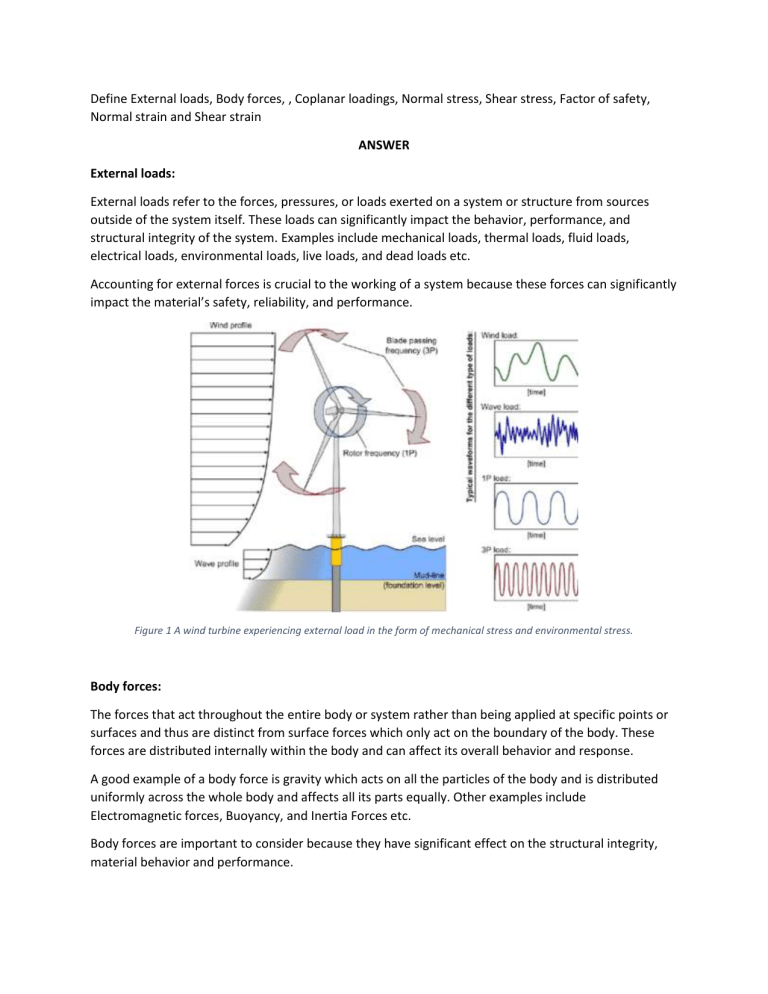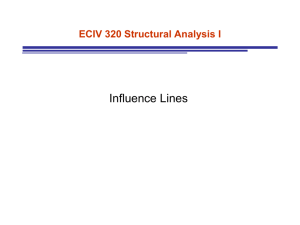
Define External loads, Body forces, , Coplanar loadings, Normal stress, Shear stress, Factor of safety, Normal strain and Shear strain ANSWER External loads: External loads refer to the forces, pressures, or loads exerted on a system or structure from sources outside of the system itself. These loads can significantly impact the behavior, performance, and structural integrity of the system. Examples include mechanical loads, thermal loads, fluid loads, electrical loads, environmental loads, live loads, and dead loads etc. Accounting for external forces is crucial to the working of a system because these forces can significantly impact the material’s safety, reliability, and performance. Figure 1 A wind turbine experiencing external load in the form of mechanical stress and environmental stress. Body forces: The forces that act throughout the entire body or system rather than being applied at specific points or surfaces and thus are distinct from surface forces which only act on the boundary of the body. These forces are distributed internally within the body and can affect its overall behavior and response. A good example of a body force is gravity which acts on all the particles of the body and is distributed uniformly across the whole body and affects all its parts equally. Other examples include Electromagnetic forces, Buoyancy, and Inertia Forces etc. Body forces are important to consider because they have significant effect on the structural integrity, material behavior and performance. Figure 2 Gravity and buoyancy; two body forces acting on an object. Coplanar loading: A set of loads or forces that are all contained within a single plane. These loads act on a structure or system along a common plane, typically referred to as the loading plane. The term "coplanar" indicates that all the forces lie in the same two-dimensional plane. Some examples of coplanar loading include Parallel Forces, Concentrated loads, Distributed loads, and Moment loads etc. The importance of coplanar loadings is the ease of calculations by reducing the problem from 3D to 2D calculation which reduces the complexity of the calculations and allowing engineers to determine forces such as internal forces, stress, and deformity etc. relatively easily. Figure 3 An example of coplanar loading by considering forces on a single plane. Normal stress: Refers to the internal force per unit area that acts perpendicular (normal) to the cross-sectional area of a material or structural element or σ = F/A where σ is the normal stress F is the force applied and A is the unit area upon which the force acts. It is a measure of the intensity of the internal forces distributed over a specific area and plays a critical role in understanding material behavior and structural analysis. It is further subdivided into two types of namely tensile stress referring to forces which elongate or stretch the material and compressive stress referring to the forces which tend to compress the material or shorten it. The importance of normal stress is such that when it exceeds the acceptable limits as defined by the material’s properties; it can cause structural instability, deformation, and material failure. Figure 4 Normal stress displayed in the form of Compression and Tensile stress. Shear stress: The internal force per unit area that acts parallel to the cross-sectional area of a material or structural element. It represents the intensity of the internal forces distributed over a specific area. Shear stress occurs when adjacent layers of a material or structural element slide or deform relative to each other along a plane parallel to the applied force. It is calculated as the ratio of the applied shear force (F) to the area (A) over which the force is distributed. Mathematically, shear stress (τ) is expressed as τ = F/A. It is essential to consider shear stress in relation to the selection of the material, design of the material, determining loading conditions and structural integrity etc. Shear stress differs from normal stress based on the orientation of force applied ( parallel vs perpendicular), Effect on material ( shearing or deformation of layers vs compression or elongation) etc. Figure 5 Shear stress as the ratio of applied force over area. Factor of safety: The factor of safety is a measure of how much a structure or component can safely withstand loads beyond the expected or design conditions. It is a ratio that compares the maximum stress a structure can endure without failure to the actual stress experienced under normal operating conditions. The factor of safety is calculated by dividing the ultimate strength or load-carrying capacity of the structure (or component) by the actual applied load or stress. Mathematically, is expressed as: Factor of Safety = Ultimate Strength / Applied Load or Stress The ultimate strength refers to the maximum load or stress that a structure can withstand before failure occurs. The applied load or stress represents the actual forces or stresses experienced by the structure during operation or under specified conditions. Significance of factor of safety is that it provides a safety margin or buffer between the actual applied loads and the maximum load the structure can handle. It ensures that the structure can withstand unforeseen or accidental variations in loading conditions, uncertainties in material properties, manufacturing tolerances, and other potential sources of failure. Normal strain: Normal strain refers to the measure of deformation or elongation experienced by a material along a specific direction due to the application of external forces or loads. It quantifies the relative change in length or dimension of a material in the direction perpendicular to the applied force. Normal strain is calculated as the ratio of the change in length (ΔL) to the original length (L₀) of the material. Mathematically, it can be expressed as: Normal Strain (ε) = ΔL / L₀ where: ΔL is the change in length of the material along the direction perpendicular to the applied force. L₀ is the original length of the material in the same direction. Normal strain is a fundamental concept used in structural analysis, material testing, and design calculations. It helps engineers assess the deformation characteristics and mechanical behavior of materials under different loading conditions. Figure 6 Strain experienced by a rod. Shear strain: Shear strain refers to the measure of deformation or distortion experienced by a material when subjected to shear stress. It represents the relative displacement or change in shape between adjacent layers of a material that are parallel to the applied shear force. Shear strain is calculated as the ratio of the change in shape or displacement (Δx) to the original length (L₀) of the material in the direction parallel to the applied shear force. Mathematically, it can be expressed as: Shear Strain (γ) = Δx / L₀ where: Δx is the displacement or change in position of adjacent layers of the material parallel to the applied shear force. L₀ is the original length of the material in the same direction. Shear strain is an important parameter in analyzing the behavior of materials and structures subjected to shear forces. It allows the assessment of the deformability, strength, and failure modes of materials under shear loading conditions. Figure 7 Strain experienced by a cuboidal object.

